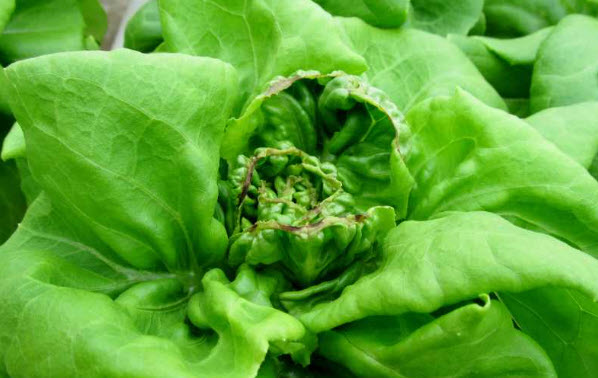Symptoms of Common Nutrient Deficiencies in
Hydroponic Lettuce & How to Fix Nutrient Deficiencies
Lettuce is one of the most produced hydroponic leafy greens in the world. But much like other greenhouse crops, it can be a challenge to keep the plants healthy and thriving throughout their growth cycle. It’s not as simple as adding vegetable fertilizer for plants or choosing a specific water-soluble vegetable fertilizer for lettuce and expecting great results. You need to follow a specific regiment and make adjustments over time.
Below, we’ll discuss the common symptoms of nutrient deficiencies in hydroponic lettuce. Then we’ll talk about how to fix them, offering some tips to prevent deficiencies in lettuce from happening.
Symptoms of common nutrient deficiencies in lettuce
Like all plants, you can overdo fertilizer for lettuce. You can also fail to give your plants enough nutrients to thrive. It’s one of the most common reasons for nutrient deficiencies in lettuce.
Lettuce is one of the most commonly grown hydroponic vegetables. Researchers at Cornell University undertook a study to identify the common nutrient deficiencies in hydroponic lettuce. This is great information to reference as you tend to your crop of lettuce plants.
Here are the common symptoms of deficiency based on the nutrient type:
- Nitrogen (N): You’ll see lighter green colour that turns to uniform chlorosis (yellowing) of older leaves.
- Phosphorus (P): Plants will likely be stunted, with reduced growth.
- Potassium (K): Presence of small necrotic spots on the margins of old leaves
- Calcium (CA): Scattered necrotic spots on young leaves and marginal necrosis and distortion of the youngest leaves
- Magnesium (Mg): Mature leaves will exhibit light interveinal chlorosis and marginal necrosis becomes visible later.
- Sulphur (S): Uniform chlorosis across the entire leaf blade.
- Iron (Fe): Interveinal chlorosis of new growth.
- Boron (B): Distorted new growth with slight marginal necrosis and leaves cupping upward.
Overall, in their research, they found noticeable deficiency symptoms of the mobile nutrients N, P, K, and Mg on mature leaves. They also identified that deficiency of immobile nutrients Ca, Fe, and B affected new growth and S deficiency led to uniform chlorosis along leaves.
Other things to note are:
- The timeline for the development of symptoms may vary.
- Many nutrient disorders are similar in appearance.
- Lab analysis of leaves is necessary to verify symptoms.
- Nutrient deficiencies may be due to environmental causes rather than to lack of nutrients in the vegetable fertilizer solution.
Lettuce With Tipburn. Photo: Tanya Merrill and Neil Mattson, Cornell University
How to fix a nutrient deficiency in your lettuce plant
Improper use of vegetable fertilizer for hydroponic lettuce is one of the most common reasons for nutrient deficiencies. How you fix a deficiency will depend on the type of nutrient deficiency. Here are some standard steps to follow to fix nutrient issues in your lettuce plant:
- Identify the lettuce plant nutrient deficiency by identifying the symptom and confirming with foliar tests
- Adjust the media pH and electrical conductivity (EC) levels to ensure ideal nutrient availability and uptake
- Add the missing nutrient by applying the right fertilizer solution. You might also be able to add a nutrient supplement.
- Adjust the irrigation schedule (if applicable)
- Check the lighting to ensure there is adequate light for the lettuce plant
- Continue to monitor the plant for ongoing or additional deficiencies.
Tips to prevent nutrient deficiencies in lettuce
Lettuce growers should always follow growing best practices when it comes to fertilization. Periodically send samples of their nutrient solution, runoff solution, and media to a laboratory to ensure that the nutrient supply is meeting the needs of the plants. Additionally, it is recommended to monitor the plants for any visible signs of nutrient deficiencies as another means of detecting any issues.
Here are some additional tips to follow:
- Use a high-quality growing medium.
- Ensure that the pH and electrical conductivity (EC) of the nutrient solution are within the recommended range.
- Use water-soluble vegetable fertilizers that are specifically formulated for lettuce at the correct amount
- Apply vegetable fertilizer according to the recommended schedule.
- Avoid overwatering or underwatering the lettuce
- Provide adequate lighting for the lettuce to promote photosynthesis and nutrient absorption.
- Keep the growing environment clean and free from pests and diseases
Want to cut your fertilizer costs and increase grower profitability?
Learn how high-quality fertilizers can help you cut fertilizer costs, and labour costs and increase your growing productivity here.
For more fertilizer productivity tips, check out these blog posts:
- 4 Things to look for in picking the best fertilizer for Fruit Trees.
- Can You Tank Mix Water Soluble Fertilizers? Pros, Cons & 5 Tips
- How Do I Know If My Plants Need Calcium?
Plant-Prod manufactures water-soluble fertilizers for fruit trees, plants and flowers. The choice of growers from California to Maine for over 70 years, Plant-Prod fertilizers are made from the finest raw ingredients in the world, tested constantly for purity and turbo-milled to ensure 100% solubility in order to help you improve yields while cutting fertilizer costs. Click here to find a Plant-Prod fertilizer supplier near you.

